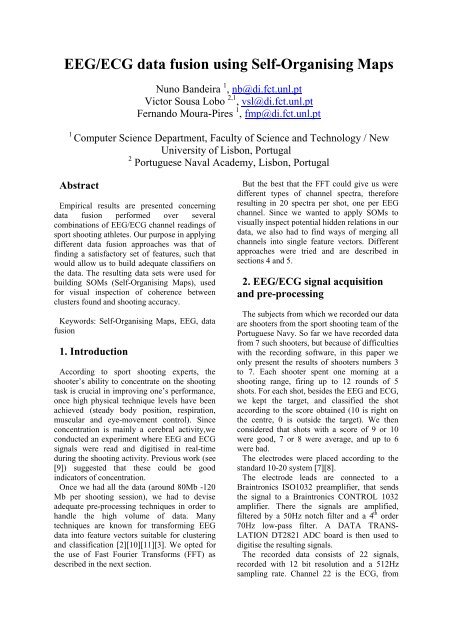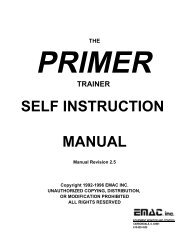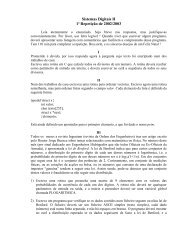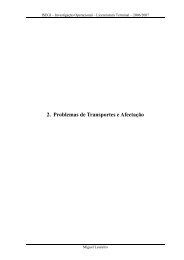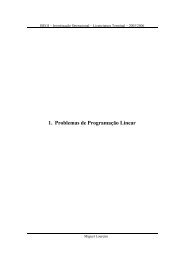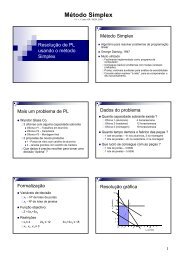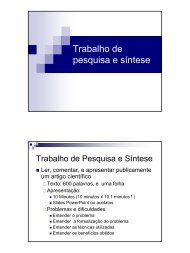EEG/ECG data fusion using Self-Organising Maps
EEG/ECG data fusion using Self-Organising Maps
EEG/ECG data fusion using Self-Organising Maps
Create successful ePaper yourself
Turn your PDF publications into a flip-book with our unique Google optimized e-Paper software.
<strong>EEG</strong>/<strong>ECG</strong> <strong>data</strong> <strong>fusion</strong> <strong>using</strong> <strong>Self</strong>-<strong>Organising</strong> <strong>Maps</strong><br />
Nuno Bandeira 1 , nb@di.fct.unl.pt<br />
Victor Sousa Lobo 2,1 , vsl@di.fct.unl.pt<br />
Fernando Moura-Pires 1 , fmp@di.fct.unl.pt<br />
1 Computer Science Department, Faculty of Science and Technology / New<br />
University of Lisbon, Portugal<br />
2 Portuguese Naval Academy, Lisbon, Portugal<br />
Abstract<br />
Empirical results are presented concerning<br />
<strong>data</strong> <strong>fusion</strong> performed over several<br />
combinations of <strong>EEG</strong>/<strong>ECG</strong> channel readings of<br />
sport shooting athletes. Our purpose in applying<br />
different <strong>data</strong> <strong>fusion</strong> approaches was that of<br />
finding a satisfactory set of features, such that<br />
would allow us to build adequate classifiers on<br />
the <strong>data</strong>. The resulting <strong>data</strong> sets were used for<br />
building SOMs (<strong>Self</strong>-<strong>Organising</strong> <strong>Maps</strong>), used<br />
for visual inspection of coherence between<br />
clusters found and shooting accuracy.<br />
Keywords: <strong>Self</strong>-<strong>Organising</strong> <strong>Maps</strong>, <strong>EEG</strong>, <strong>data</strong><br />
<strong>fusion</strong><br />
1. Introduction<br />
According to sport shooting experts, the<br />
shooter’s ability to concentrate on the shooting<br />
task is crucial in improving one’s performance,<br />
once high physical technique levels have been<br />
achieved (steady body position, respiration,<br />
muscular and eye-movement control). Since<br />
concentration is mainly a cerebral activity,we<br />
conducted an experiment where <strong>EEG</strong> and <strong>ECG</strong><br />
signals were read and digitised in real-time<br />
during the shooting activity. Previous work (see<br />
[9]) suggested that these could be good<br />
indicators of concentration.<br />
Once we had all the <strong>data</strong> (around 80Mb -120<br />
Mb per shooting session), we had to devise<br />
adequate pre-processing techniques in order to<br />
handle the high volume of <strong>data</strong>. Many<br />
techniques are known for transforming <strong>EEG</strong><br />
<strong>data</strong> into feature vectors suitable for clustering<br />
and classification [2][10][11][3]. We opted for<br />
the use of Fast Fourier Transforms (FFT) as<br />
described in the next section.<br />
But the best that the FFT could give us were<br />
different types of channel spectra, therefore<br />
resulting in 20 spectra per shot, one per <strong>EEG</strong><br />
channel. Since we wanted to apply SOMs to<br />
visually inspect potential hidden relations in our<br />
<strong>data</strong>, we also had to find ways of merging all<br />
channels into single feature vectors. Different<br />
approaches were tried and are described in<br />
sections 4 and 5.<br />
2. <strong>EEG</strong>/<strong>ECG</strong> signal acquisition<br />
and pre-processing<br />
The subjects from which we recorded our <strong>data</strong><br />
are shooters from the sport shooting team of the<br />
Portuguese Navy. So far we have recorded <strong>data</strong><br />
from 7 such shooters, but because of difficulties<br />
with the recording software, in this paper we<br />
only present the results of shooters numbers 3<br />
to 7. Each shooter spent one morning at a<br />
shooting range, firing up to 12 rounds of 5<br />
shots. For each shot, besides the <strong>EEG</strong> and <strong>ECG</strong>,<br />
we kept the target, and classified the shot<br />
according to the score obtained (10 is right on<br />
the centre, 0 is outside the target). We then<br />
considered that shots with a score of 9 or 10<br />
were good, 7 or 8 were average, and up to 6<br />
were bad.<br />
The electrodes were placed according to the<br />
standard 10-20 system [7][8].<br />
The electrode leads are connected to a<br />
Braintronics ISO1032 preamplifier, that sends<br />
the signal to a Braintronics CONTROL 1032<br />
amplifier. There the signals are amplified,<br />
filtered by a 50Hz notch filter and a 4 th order<br />
70Hz low-pass filter. A DATA TRANS-<br />
LATION DT2821 ADC board is then used to<br />
digitise the resulting signals.<br />
The recorded <strong>data</strong> consists of 22 signals,<br />
recorded with 12 bit resolution and a 512Hz<br />
sampling rate. Channel 22 is the <strong>ECG</strong>, from
where the heart beat rate is extracted <strong>using</strong> a<br />
simple spectra based algorithm. Channel 18 is<br />
the signal of the right ear, that is used as<br />
reference for the differential amplifiers, and<br />
thus contains no information. The remaining 20<br />
channels are all subject to the same initial preprocessing.<br />
First, the last 5 seconds before the<br />
shot are selected (2.5K points). This signal is<br />
then broken up into 9 blocks of 512 points, with<br />
50 % overlap between them (so as to later<br />
obtain a Walsh periodogram). Each of these<br />
blocks is then multiplied by a Hamming<br />
window to reduce frequency leakage, and it’s<br />
spectrum is calculated with a 512 point FFT.<br />
Thus each channel produces 9 spectra with 256<br />
bins of real frequencies and a width of 1Hz.<br />
Since we used a 70Hz low-pass filter and<br />
standard <strong>EEG</strong> bands range from 1-30Hz we<br />
opted for <strong>using</strong> only the lower 30 bins.<br />
Thus, when all information is used, we have<br />
20 <strong>EEG</strong> channels with 9 spectra of 30 bins,<br />
totaling 5400 <strong>EEG</strong> features, plus one heart beat<br />
rate feature. All subsequent pre-processing is<br />
done on this <strong>EEG</strong> <strong>data</strong>.<br />
3. SOM - <strong>Self</strong> <strong>Organising</strong> <strong>Maps</strong><br />
<strong>Self</strong>-<strong>Organising</strong> <strong>Maps</strong>, also known as<br />
Kohonen <strong>Maps</strong>, in honour of its creator, are<br />
thoroughly described in [5] and have been<br />
widely used in many applications, including as<br />
a tool for <strong>data</strong> <strong>fusion</strong> [4] (an excellent<br />
bibliography can be found in<br />
http://www.cis.hut.fi/nnrc/index.html). The<br />
SOM concept is based on the human brain’s<br />
cortex interactions, simplified in a model in<br />
which different prototypes (neurones) try to<br />
represent the input <strong>data</strong> by competing with each<br />
and every other neurone in every iteration, for a<br />
better mapping of the input <strong>data</strong>.<br />
The basic SOM algorithmic procedure is as<br />
follows:<br />
1. For a given training pattern x:<br />
1.1 Calculate the distance of each neurone to<br />
the training pattern x (Calculation phase)<br />
1.2 Find the neurone with smaller distance,<br />
and call it the winner W (Voting phase)<br />
1.3 Change the network neurones with a<br />
function G, which depends on the learning<br />
rate α, the distance d to W (in the output<br />
plane), and the neighbourhood function F.<br />
Due to the nature of the neighbourhood<br />
function, only the neurones closer to W (in<br />
the output space) will be changed. (Update<br />
phase)<br />
2. Update the learning rate α and the<br />
neighbourhood function F according to<br />
some rule<br />
3. Repeat steps 1 and 2 for the next training<br />
pattern, until some stopping criteria is<br />
reached.<br />
In all our analysis we ran our algorithms 6<br />
times with different initial values, to make sure<br />
that the process always converged to the same<br />
final map. Whenever this did not happen, we<br />
simply increased the number of iterations and<br />
the initial learning radius until a stable solution<br />
was found.<br />
A distributed SOM implementation was also<br />
used in building the maps for the largest <strong>data</strong>set<br />
(5401 features). A detailed description of this<br />
algorithm and its empirical evaluation can be<br />
found in [1].<br />
To visualise the results of the clustering<br />
performed by SOM, we frequently used Umatrices<br />
[12]. The U-Matrix of a SOM is<br />
obtained by calculating the distance, in the<br />
input space, between neighbouring neurones.<br />
These distances are then represented on a map<br />
in grayscale (black being the greatest distance,<br />
and white the smallest). Clusters can easily be<br />
identified as clear areas (nearby neurones)<br />
separated by dark ridges (large distances to<br />
other clusters).<br />
4. Data <strong>fusion</strong><br />
Since our main objective was finding an<br />
adequate set of features that would provide high<br />
visual correlation between the <strong>EEG</strong> signal and<br />
shooting performance, most of our work at this<br />
stage was concentrated on <strong>data</strong> <strong>fusion</strong>.<br />
Due to this fact, <strong>data</strong> <strong>fusion</strong> was performed<br />
<strong>using</strong> different types of feature aggregation,<br />
motivated by several different reasons. Each<br />
choice of feature aggregation led to a different<br />
training set, upon which the clustering<br />
procedure was applied.<br />
The training sets used were:<br />
I) All the features (1 set of 5401 features).<br />
In this training set, all features mentioned in<br />
Section 2 are used. It seems reasonable that<br />
this approach would capture the dynamics of<br />
the signal prior to the shot. In this set, the<br />
heart beat rate is also used.<br />
II) All average spectra. (1 set of 601 features).
In this training set, we averaged the spectra of<br />
each channel, and by doing so assumed that<br />
the signals are stationary during the 5 seconds<br />
before the shot. Each resulting spectrum is the<br />
average of 9 spectra, and thus the signal to<br />
noise ratio is improved considerably. In this<br />
set, the heart beat rate is also used.<br />
III) Average spectra separated by hemisphere (2<br />
sets of 330 features).<br />
In these training sets, we separated the <strong>data</strong> in<br />
right and left hemisphere. Each hemisphere<br />
consists of 8 <strong>EEG</strong> channels unique to that<br />
hemisphere, plus the three central channels<br />
(Fz, Cz, Pz [7][8]). This choice of features is<br />
motivated by the fact that the left and right<br />
sides of the brain are reasonably distinct and<br />
all but one of the shooters were right handed<br />
and used the right eye for aiming. We<br />
performed clustering on each side separately,<br />
and later merged the results.<br />
IV) Average spectra by channel (19 sets of<br />
30 features).<br />
In these training sets, we used the spectra of<br />
each channel as a separate training set. By<br />
analysing the ability to cluster the <strong>data</strong><br />
sensibly, based on each channel<br />
independently, we tried to determine if there<br />
were any channels more relevant to the task at<br />
hand.<br />
V) Characteristic frequency bands (4 sets of<br />
120 features for the alpha band, 320 for beta,<br />
and 80 for delta and theta).<br />
In these training sets, power spectra within<br />
each band (alpha, beta, delta, and theta [6])<br />
were selected for all channels. Since each<br />
band has a different width, the number of<br />
features selected varies. According to classic<br />
literature in the area [6] these frequency bands<br />
correspond to well established activity<br />
patterns within the brain, and thus are the<br />
natural choice for discriminating between the<br />
shots.<br />
5. Decision <strong>fusion</strong><br />
Decision <strong>fusion</strong> was used for merging the<br />
results obtained in III and IV. The generated<br />
<strong>data</strong>sets were used in building the<br />
corresponding SOMs, which were then labelled<br />
<strong>using</strong> the same <strong>data</strong>sets. Labelling a SOM<br />
consists in finding the winning neurone in a<br />
SOM for each <strong>data</strong> vector in the <strong>data</strong>set and<br />
appending the <strong>data</strong> vector’s class label to the<br />
neurone’s label. This labelling (usually called<br />
calibration in SOM terms) allowed us to use the<br />
SOMs as classifiers, simply by having each<br />
neurone belong to the class that, in its label, is<br />
most frequent.<br />
Two different strategies were applied in<br />
f<strong>using</strong> the SOMs classifications:<br />
- Majority (III, IV). This is the simplest<br />
decision <strong>fusion</strong>, where the final class is<br />
simply the most ocurring class in the<br />
lower level classifiers. It is used for<br />
evaluation of variation in SOMs<br />
classifications.<br />
- Use of another SOM layer (IV). In this<br />
case, the results of the classification by<br />
the original SOMs are fed as features to a<br />
f<strong>using</strong> SOM. It is then used for visual<br />
inspection of dispersion of the first level<br />
SOMs classifications. Higher levels of<br />
agreement on the first level SOMs should<br />
lead to a smooth <strong>fusion</strong> SOM. If the<br />
decision <strong>fusion</strong> SOM is messy or has<br />
outliers, then there is disagreement on the<br />
first level SOMs. In such cases, simply by<br />
glancing at the outliers’ neighbours it’s<br />
easy to spot which class most of the first<br />
level classifiers chose for it.<br />
6. Results<br />
With all <strong>data</strong>sets, with the exceptions of VI<br />
that will be discussed later, and certain channels<br />
of IV, the <strong>data</strong> was clustered by shooter. We<br />
present these results for the first <strong>data</strong>set in<br />
Figure 2, and the others are very similar.<br />
Since the <strong>data</strong> is clustered by shooter, it<br />
cannot be clustered by score. So as to cluster by<br />
score, it is necessary to join all good shots in<br />
one cluster and bad ones in another, thus<br />
mixing in those clusters the different shooters<br />
(which as in this case does not happen). Thus,<br />
to classify the shots by score we have to analyse<br />
the <strong>data</strong> of each shooter individually.<br />
None of the <strong>data</strong>sets tested provides good<br />
clustering by score for all shooters. However, 2<br />
of the individual channels (F7 and T3) provided<br />
reasonable clustering by scores, even when all<br />
shooters are considered simultaneously.<br />
Furthermore, some of the shooters have their<br />
shots clustered by score with some of the<br />
<strong>data</strong>sets. Shooter 3 has his shots clustered by<br />
score in <strong>data</strong>set IV (channel Cz), shooter 4 in<br />
<strong>data</strong>set V, shooter 5 in <strong>data</strong>sets II, IV and V,<br />
and shooter 7 in <strong>data</strong>set IV. With shooter 6 no
<strong>data</strong>set was capable of clustering his shots by<br />
score.<br />
To visualise the maps produced, we shall<br />
represent the mapped shots as crosses if they<br />
correspond to good shots, triangles if they<br />
correspond to average shots, and circles<br />
otherwise, as shown in Figure 1.<br />
Figure 1 - Legend for the maps<br />
The results for each of the training sets<br />
presented in section 4 are as follows:<br />
I) Training set with all 5401 features.<br />
Different shooters are clearly identified for, as<br />
we can see in Figure 2, shooters 4 and 5 have<br />
very distinct clusters (separated from the others<br />
by dark lines in the U-Matrix), and shooters 6,<br />
7, and 3, while in the same cluster, are mapped<br />
to different areas. To obtain these maps we used<br />
the distributed version of SOM mentioned in<br />
section 3. This allowed us to reduce the total<br />
training time of each map from 2h21m to<br />
1h16m when <strong>using</strong> 2 machines, and even more<br />
when more machines where available.<br />
6 6 6 6 6 7 7 4 4 4 4<br />
6 6 7 7 7 4 4 4<br />
7 6 6 6 6 6 7 4 4 4<br />
6 6 6 6 6 6 4 4 4<br />
6 6 6 6 6 3 3 3 4<br />
6 5 3 3 3 4 4 4<br />
5 5 5 5 3 3 3<br />
5 5 5 5 3 3 3 4 4 4<br />
Figure 2 - U-Matrix obtained after applying a<br />
SOM to training set I.<br />
If we train SOM maps for each individual<br />
shooter, the results are generally bad.<br />
II) Training set with Average Spectra (601<br />
features)<br />
This training set is only useful for shooter 5.<br />
In Figure 3 we can see that all good shots are<br />
on the upper right corner, while the average<br />
shots are on the bottom left. Furthermore, in<br />
the U-Matrix presented in Figure 4 we can see<br />
that there is a clear distinction between these<br />
two areas. It could be argued that there are<br />
some good shots in the “bad area”, but these<br />
are probably outliers that correspond to lucky<br />
shots that are good despite the bad conditions.<br />
Figure 3 - Map obtained with training set II<br />
for shooter 5<br />
9 9 10 9<br />
8 10 9<br />
10 9 9 9<br />
8 9 8 9<br />
Figure 4 - U-Matrix obtained with training set<br />
II for shooter 5.<br />
III) Training set with average spectra separated<br />
by hemisphere (2 sets of 330 features).<br />
We were unable to obtain good clusters of the<br />
<strong>data</strong> by scores for any shooter with this <strong>data</strong>set.<br />
However, as with all others, we could cluster<br />
rather easily by shooter. When we fused the<br />
results obtained by each hemisphere, we<br />
managed to obtain the results presented in<br />
Table 1.<br />
3 4 5 6 7 All<br />
Best<br />
Hemisphere<br />
50 70 57 53 45 47<br />
Fusion 53 70 70 58 60 55<br />
Gain 3 0 13 5 14 8<br />
Table 1 - Percentage of correct classification<br />
for each shooter, with and without decision<br />
<strong>fusion</strong><br />
IV) Training set with average spectra by<br />
channel (19 sets of 30 features).<br />
10
IV.i) Individual Channels<br />
Channels F7 (left frontal), and T3 (left<br />
temporal) proved to be quite good at clustering<br />
by score. Figure 5 shows the results for all<br />
shooters, and we can see an area of bad shots on<br />
the left center, and an area of “con<strong>fusion</strong>” on<br />
the lower right, with good shots on most other<br />
areas.<br />
Figure 5 - Map obtained with training set IV,<br />
channel T3, for all shooters.<br />
When considering individual shooters, shooter<br />
5 again has his shots clustered by score, but<br />
now we can also do the same for shooter 7 and<br />
3, as can be seen in Figure 6 and Figure 7.<br />
Figure 6 - Map obtained with training set IV,<br />
channel Cz, for shooter 3.<br />
Figure 7 - Map obtained with training set IV,<br />
channel Fz, for shooter 7<br />
IV.ii) Fusion by majority<br />
As can be seen in Table 2, the biggest<br />
improvements were achieved with shooter 4<br />
and all shooters together, with an increase of<br />
18% and 17% of correct answers. Average<br />
improvement was 11%.<br />
3 4 5 6 7 ALL<br />
Best<br />
channel<br />
57 72 75 56 60 51<br />
Fusion 67 83 75 69 78 68<br />
Gain 10 11 0 13 18 17<br />
Table 2 - Percentage of correct classifications<br />
for each shooter, with and without decision<br />
<strong>fusion</strong><br />
IV.iii) Fusion by another SOM layer<br />
As expected from shooter 4’s low error rate<br />
in <strong>fusion</strong> by majority, his map is pretty<br />
clean, having only one average shot amidst<br />
the bad shots, as can be seen in Figure 8.<br />
Figure 8 – Results of <strong>fusion</strong> of the individual<br />
channels by a SOM, for shooter 4.
Figure 9 - Results of <strong>fusion</strong> with a SOM layer<br />
for shooter 6.<br />
Figure 10 - Results of <strong>fusion</strong> with a SOM<br />
layer for shooter 3.<br />
On the other hand, the maps of Figure 9 and<br />
Figure 10 show that shooters 3 and 6 are in very<br />
distinct situations, although their results in<br />
<strong>fusion</strong> by majority are quite similar. In shooter<br />
6’s map there are many neurones that have both<br />
good and average class labels, indicating that<br />
this set of features is not good enough. In<br />
shooter 3’s map, we can observe that this<br />
choice of features led to an embedding of the<br />
average shots amidst the good ones (in the<br />
SOM’s 2D projection). This leads to the<br />
conclusion that, for the <strong>data</strong> vectors in the<br />
bottom left corner, most of the single-channel<br />
SOMs classified these good shots as below<br />
average. So in this case, what we have is not a<br />
mix-up, but a set of <strong>data</strong> vectors that should be<br />
put aside and carefully analysed. A possible<br />
solution to this kind of error could be the<br />
addition of another classifier, prior to decision<br />
<strong>fusion</strong>, that would mainly handle this cluster.<br />
V) Training sets with characteristic frequency<br />
bands (alpha beta, delta and theta).<br />
The alpha band, separated the shooters better<br />
then most others, with the advantage that it uses<br />
only 6 features. It was also useful in separating<br />
shooter 5’s shots by score, as can be seen in<br />
Figure 11.<br />
Figure 11 - Map obtained with training set V,<br />
Alpha band, for shooter 5.<br />
The beta band provided the best separation of<br />
all amongst shooters. It was however useless in<br />
separating by score, as was the theta band.<br />
The delta band provided a reasonable clustering<br />
of shooter 4’s scores, as can be seen in Figure<br />
12.<br />
Figure 12 - Map obtained with training set V,<br />
delta band, for shooter 4.<br />
6. Conclusion<br />
Our main objective in this first phase of our<br />
work was to gain further insight over our <strong>data</strong>,<br />
which was accomplished. Although most of the<br />
<strong>data</strong> <strong>fusion</strong> possibilities had a strong imprint of<br />
each individual’s personal <strong>EEG</strong> traces, we were<br />
able to find some clues as to what were the<br />
important frequency ranges in each case. These<br />
have already led us to try and find new criteria<br />
that combine different frequency bands, on<br />
which we are currently working.<br />
The <strong>data</strong> from the <strong>ECG</strong> did not influence in<br />
any way our results, since it was almost
constant for each shooter, and even amongst<br />
shooters the differences were not significant.<br />
Our use of SOMs as a clustering tool for<br />
visual inspection of our <strong>data</strong> <strong>fusion</strong> options was,<br />
as we expected, very useful. Also, decision<br />
<strong>fusion</strong> wise, we found SOMs to be very useful<br />
as a visual inspection tool of a set of classifiers.<br />
High coherence means cleaner, smoother maps,<br />
messy maps mean lots of variance within the<br />
classifier set and maps with disjoint clusters<br />
could be good indicators that an extra classifier<br />
is needed to handle specific <strong>data</strong> partitions.<br />
7. Bibliography<br />
[1] Bandeira N, Lobo V, Moura-Pires F:<br />
Training a <strong>Self</strong>-Organizing Map Distributed on<br />
a PVM Network, Proceedings of IEEE Joint<br />
Conference on Neural Networks, 1998<br />
[2] John ER, Prichep LS : Principles of<br />
Neurometric analysis of <strong>EEG</strong> and Evoked<br />
Potentials, Electroencephalography, 4th ed<br />
(Niedermeyer E, ed), Williams & Wilkins,<br />
1993, 989-1003<br />
[3] Kalayci T, Özdamar Ö : Wavelet preprocessing<br />
for automated neural network<br />
detection of <strong>EEG</strong> spikes, IEEE Engineering in<br />
Medicine and Biology, March/April 1995, 160-<br />
166<br />
[4] Lobo VS, Bandeira N, Moura-Pires F:<br />
Distributed Kohonen Networks for Passive<br />
Sonar Based Classification, Proceedings of the<br />
International Conference on Multisource-<br />
Multisensor Information Fusion – FUSION 98<br />
[5] Kohonen T : <strong>Self</strong>-Organizing <strong>Maps</strong>,<br />
Springer-Verlag, 1995<br />
[6] Niedermeyer E: The Normal <strong>EEG</strong> of the<br />
Waking Adult, in Electroencephalography, 4th<br />
ed (Niedermeyer E, ed), Williams & Wilkins,<br />
1993, 131-152<br />
[7] Nuwer MR, et al.: IFCN guidelines for<br />
topographic and frequency analysis of <strong>EEG</strong>s<br />
and EPs. Report of an IFCM committee.<br />
[8] Reilly E: <strong>EEG</strong> Recording and Operation of<br />
the Apparatus, in Electroencephalography, 4th<br />
ed (Niedermeyer E, ed), Williams & Wilkins,<br />
1993, 104-124.<br />
[9] Schober F, Schellenberg R, Dimpfel W :<br />
Reflection of mental exercise in the dynamic<br />
quantitative topographical <strong>EEG</strong>,<br />
Neuropsychobiology 1995;31; 98-112<br />
[10] Silva FL : <strong>EEG</strong> analysis: Theory and<br />
Practice, Electroencephalography, 4th ed<br />
(Niedermeyer E, ed), Williams & Wilkins,<br />
1993, 1097-1123<br />
[11] Silva FL : Computer-assisted <strong>EEG</strong><br />
diagnosis: Pattern recognition and brain<br />
mapping, in Electroencephalography, 4th ed<br />
(Niedermeyer E, ed), Williams & Wilkins,<br />
1993, 1063-1086<br />
[12] Ultsch A: Siemon, H.P.; “Exploratory<br />
Data Analysis Using Kohonen Networks on<br />
Transputers”, Dep.of Comp.Science, Dortmund<br />
FRG, December 1989.


